This site is made possible by its sponsors.
Please visit them!
xanthic or xanthine - Of, relating to, or tending toward a yellow color. "Xanthic" has its roots in the Greek word "xanthos" which means "yellow." "Xantho-" and "xanth-" are prefixes which also mean yellow.
(pr. ZAN-thək)
xenophilia - Love of the foreign or unfamiliar. A xenophile is a person attracted to that which is foreign (or ethnic), especially to foreign peoples, manners, or cultures. In Western societies during the 1990s, in reaction to the prevailing opinion that the great accomplishments have been made almost exclusively by males of European descent (DWMs), there was a xenophilic embrace of works by women, non-whites and the dispossessed.
(pr. ZE-nə-FEE-lee-ə)
Also see antiquarianism, attitude, bias, chinoiserie, discrimination, empathy, ethnosphere, feminism and feminist art, First
Amendment rights, gender issues, humanism, lookism, motivation, multiculturalism, political correctness, praise, and xenophobia.
![]()
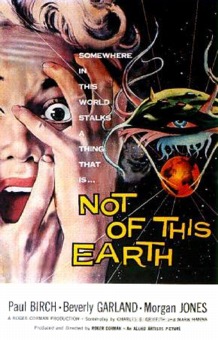
![]() xenophobia - Irrational fear or hatred of anything
foreign or unfamiliar — different. Currently rampant xenophobias include the fear of social or foreign (ethnic)
groups — racism, sexism, homophobia, and religious
intolerance.
xenophobia - Irrational fear or hatred of anything
foreign or unfamiliar — different. Currently rampant xenophobias include the fear of social or foreign (ethnic)
groups — racism, sexism, homophobia, and religious
intolerance.
People tend to fear or distrust those who are not like themselves. When we convince ourselves that our way is the "right" way, we are more likely to strike out at those people or ideas that are different. Intolerance of differences can result in prejudices, segregation, jingoism, colonial subjugation, exploitation, vandalism, persecution, and ultimately genocide (aka "ethnic cleansing"). Xenophobia is indeed one of the principal causes of violence around the world.
Xenophobia has increased with the growth of various fundamentalist religious movements — notably within every major monotheistic religion, each of which has been frustrated that it has failed to fill the huge spiritual void of modernity — one that Jean-Paul Sartre called "a God-shaped hole."
A xenophobe is a person who is unduly fearful or contemptuous of anything foreign, such as of strangers or foreign peoples.
A xenophobia specific to the art world is sometimes seen in a viewer's off-hand dismissal of art, art not immediately understood. Although such intolerance might otherwise reveal common laziness, such refusal to attempt to understand art can arise from an incapacity to tolerate deviation from a perceived norm. There is a long history to intolerance directed toward art and artists.
Examples:
In the last century, the rise of modernism witnessed a powerful backlash from those who saw works of each avant-garde art movement as tasteless or ugly or bad art, as insulting the public, as mean jokes, as radical political propaganda, etc.
Examples:
The reaction to the Armory
Show in New York City in 1914. Another is the Nazi's program
of condemning modernist art and artists as degenerate
(see fascist aesthetic).
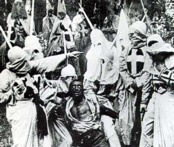
![]()
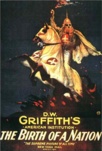
![]()
D.W. Griffith (American, 1875-1948), producer and director, The Birth of a Nation, 1915, silent film, 187 minutes. Does the masked horseman on this poster bring justice or terror? The Birth of a Nation was an early full-length motion picture that dramatized an American Civil War narrative. It emphasized a xenophobic portrayal of blacks, and promoted violence against them by the Ku Klux Klan. In the scene from which this still was taken, the "renegade Negro," Gus, played by white actor Walter Long in blackface, is killed following a "trial" conducted by the Klan. Griffith's film was propaganda for a revival of the KKK. See cinema.
Attempts in the last few years to discipline museums and other organizations that have supported or mounted exhibitions of controversial works in the United States and elsewhere. (See National Endowment for the Arts (NEA).)

![]()
![]()
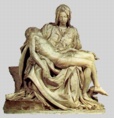
Vandals have targeted numerous works of
art. Most vulnerable have been works in public places, such as
in parks and museums. These works include such Renaissance masterworks as Leonardo's
Mona Lisa (La Joconde), Michelangelo's Rome Pietà, as well as works of
other periods by such artists as Rembrandt and van Gogh, among
many others.
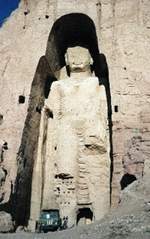
![]() In the spring of
2000, Afghanistan's Taliban (Islamic extremists
in power) destroyed colossal statues of the Buddha, carved from
a living rock cliff at Bamiyan, 145 km west of Kabul, Afghanistan,
long before the arrival of Islam in that area. One of the statues
was 53 meters high and dated to the 5th century; the other was
37 meters tall and dated to the 3rd century. These were rare
examples of statuary in the Greco-Buddhist style, priceless ancient
relics of this important cultural crossroads. Several thousand
monks once lived in the caves next to the statue. The Taliban's
supreme leader, Mullah Mohammed Omar, ordered the destruction
in an edict, saying such images were contrary
In the spring of
2000, Afghanistan's Taliban (Islamic extremists
in power) destroyed colossal statues of the Buddha, carved from
a living rock cliff at Bamiyan, 145 km west of Kabul, Afghanistan,
long before the arrival of Islam in that area. One of the statues
was 53 meters high and dated to the 5th century; the other was
37 meters tall and dated to the 3rd century. These were rare
examples of statuary in the Greco-Buddhist style, priceless ancient
relics of this important cultural crossroads. Several thousand
monks once lived in the caves next to the statue. The Taliban's
supreme leader, Mullah Mohammed Omar, ordered the destruction
in an edict, saying such images were contrary  to Islam.
"These idols have been gods of the infidels, who worshiped
them, and these are respected even now and perhaps maybe turned
into gods again," his edict said. Other resources on this
story: 1 and 2. (See Buddhist
art, Islamic
art and Islamism,
and living rock.)
to Islam.
"These idols have been gods of the infidels, who worshiped
them, and these are respected even now and perhaps maybe turned
into gods again," his edict said. Other resources on this
story: 1 and 2. (See Buddhist
art, Islamic
art and Islamism,
and living rock.)
In April of 2006, Sydney McGee, an elementary art teacher at Wilma Fisher Elementary School (in the Dallas, TX, exurb of Frisco), led fifth graders through European and contemporary galleries of the Dallas Museum of Art. One of her students saw nude art in the museum, and after the child’s parent complained, Ms McGee was suspended. Although the tour had been approved by the principal, and the 89 students were accompanied by four other teachers, at least twelve parents and a museum docent, Principal Nancy Lawson reprimanded Ms. McGee, saying: “During a study trip that you planned for fifth graders, students were exposed to nude statues and other nude art representations.” Although school representatives have said that other concerns prompted Ms McGee's dismissal, the evidence betrays this school community's xenophobia, or of the specific phobia called gymnophobia. See a NY Times article about this story.
An important goal of education (as it is of art) is to challenge students to consider more advanced ideas. In doing so, viewers must see images that some might consider problematic. Approaching the examination of disturbing subjects, educators are wise to gauge community concerns, and to accomodate them in some ways. Nevertheless, it is generally appropriate to expect that maturing students can and should view many challenging works in a scholarly manner, and that their scholarly pursuits are not be impeded by gymnophobia.
Today, a syndrome of intolerance continues to develop from peoples' irritation with the ascendancy of modernism and postmodernism, and from the inevitably mixed results (ranging from the worst through the best achievements) of secular, democratic societies. This hatred often results in disputes over artists' freedom of expression (in the US, called First Amendment rights).
Numerous xenophobias have provided important issues for many recent artists.
(pr. ZE-nə-FOH-bee-ə)
Examples of works whose subject is xenophobia:

Guerrilla Girls (American, contemporary, a group founded in 1985 by otherwise unnamed feminist women), Pop Quiz: If February is Black History Month and March is Women's History Month, What Happens the Rest of the Year? 1990, poster. "Oh, those special months of the year! Assigning commemorative months to social issues has become another form of tokenism. This poster is a favorite on university campuses where African Americans and women always get art shows in February and March." Visit the Guerrilla Girls site to see more of their work.
James Victore, Racism, poster, 1994.
Ralph Applebaum Associates, United States Holocaust Memorial Museum, exhibition design, 1995.
Quote:
“The presence of fear means only that fear is present, and nothing more,”
Suzanne Segal (contemporary American), Zen Buddhist teacher.
Other resources:
A related, and more obscure term is "albophobia," the fear or hatred of white people.
Also see aesthetics, African American art, angst, bias, censorship, degenerate, discrimination, ethnocentrism, Eurocentrism, existentialism, feminism and feminist art, First Amendment rights, gender issues, iconoclast, iconomachy, iconophobia, lookism, motivation, multiculturalism, National Endowment for the Arts (NEA), pain, stereotype, transgressive, ugly, and xenophilia.
xerography - A dry photographic or photocopying process in which a negative image formed by a resinous powder on an electrically charged plate is electrically transferred to and thermally fixed as positive on a paper or other copying surface. Xerox is a trademark.
Also see photocopy.
x-ray or X-ray or x ray or X ray
- A photon with a wavelength
approximately 0.01 to 10 nanometers.  More likely a stream of such photons,
also known as roentgen rays (after
More likely a stream of such photons,
also known as roentgen rays (after  Wilhelm Konrad Roentgen, the
discoverer of x-rays and developer of x-ray photography).
X-ray may also refer to a photograph taken with x-rays, also called
a radiograph. Radiographs are
most commonly made by physicians of course (as done to see the bone
structure of a human
Wilhelm Konrad Roentgen, the
discoverer of x-rays and developer of x-ray photography).
X-ray may also refer to a photograph taken with x-rays, also called
a radiograph. Radiographs are
most commonly made by physicians of course (as done to see the bone
structure of a human hand or
head), but are also made of art objects to better see what is beneath their surfaces,
in hopes of revealing information about their making, and alterations
over time. Typical examples
are radiographs of mummies, and of paintings that have been painted over, are in need of conservation,
or are suspected forgeries.
Also see angstrom, infrared reflectography (IR) and reflectogram, overpainting, and ultraviolet.
xylene - Toluene is a gas or liquid used as a solvent
and as a thinner for certain inks (e.g.,
some permanent markers), paints,
and varnishes. It is typically
a synthetic chemical with
a sweet-smelling odor, produced from petroleum, and found in gasoline,
aviation
fuel, and cigarette smoke. Xylene is hazardous
because its vapor is toxic.
Keep out of the reach of children.
(pr. ZI:-leen)
Also see clean up and Material Safety Data Sheet (MSDS).
xylography - A printing technique that involves carving text in relief upon a wooden block, which is then inked and an impression made on paper. "Xylography" combines "xylo-," meaning "wood," and "-graphy," which denotes writing in a specified manner. "Xylography" didn't appear in print in English until 1816, but it is linked to printing practices that are much older. The oldest known printed works were produced by this method in Japan and China during the 8th and 9th centuries. This method of wood-block printing appeared in Europe in the 14th century, and eventually inspired Johannes Gutenberg to create individual and reusable ("movable") pieces of type out of metal. These days, "xylography" can also describe the technique of engraving wood for purely artistic purposes.
(pr. zi:-LAH-grə-fee)
Also see incunabulum.
YAM - See Youth Art Month (YAM).
yard - A unit of distance measurement equal to three feet, or 36 inches. To convert yards into centimeters, multiply them by 91.44; into meters, x 0.9144. Abbreviated yd.

yasti - In Buddhist architecture, a spire with three chatras, or circular disks which is the topmost element on the dome of a stupa. The yasti symbolizes the universe. It is surrounded by a harmika — a square fence-like enclosure symbolizing heaven.

Japan, Nara
Period, 8th century, Bowl with cover having a yasti-shaped handle,
sahari (a copper alloy),
mouth diameter 6.5, overall
height 9.3 cm, Tokyo National
Museum. Japanese authorities have designated this piece of the
Horyuji Treasure an "Important Cultural Property." See
yasti.
Also see crown, finial, pillar, and tower.
Yayoi - An early period in Japanese art history, from about 200 BCE - 200 CE. It was the first metal-using culture in Japan. The Yayoi period was preceded by the Jomon period (c. 450-200 BCE), and followed by the Kofun period (200-500 CE).
Example:

Japan, Dotaku, early Yayoi Period, 2nd-1st century
BCE,
bronze dotaku,
height 42.7 cm, reportedly
excavated in Kagawa Prefecture,
Tokyo National Museum. Japanese authorities consider this a "National
Treasure."

Japan, Footed Jar, late Yayoi period,
3rd century CE,
from Takakura site, Atsuta-ku, Nagoya-shi, Aichi, fired clay,
height 24.6 cm, Tokyo National
Museum. Japanese authorities consider this an "Important
Cultural Property." See footed.
yd. - Abbreviation for yard. Also see measure.
yellowing - In painting, a tendency on the part of binding media to turn a tint towards yellow. This is most likely to occur when linseed oil is included.

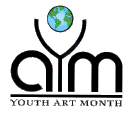 Youth Art Month (YAM) - Youth Art Month is an annual observance,
sponsored by The
Council for Art Education, Inc. (CFAE), each March to emphasize
the value of art and art education for all children and to encourage
public support for quality school art programs. Established in
1961, YAM provides a forum to support art education by developing
self-esteem, appreciation of the work of others, self-expression,
cooperation with others, and critical thinking skills.
Youth Art Month (YAM) - Youth Art Month is an annual observance,
sponsored by The
Council for Art Education, Inc. (CFAE), each March to emphasize
the value of art and art education for all children and to encourage
public support for quality school art programs. Established in
1961, YAM provides a forum to support art education by developing
self-esteem, appreciation of the work of others, self-expression,
cooperation with others, and critical thinking skills.
In 1984, the CFAE was created by Art & Craft Materials Institute (ACMI) to administer the national Youth Art Month program and to encourage funding for the program.
In 2004, members of the Council include:
See advocacy and children's art.
Yuan or Yüan - A Chinese dynasty which lasted 1279-1368.
Examples of works from this period:

China, Panel, 1279-1368, silk, gold paper, and
metallic thread on silk, 8 1/2 x 10 1/4 inches (21.6 x 26 cm),
Metropolitan Museum of Art, NY.

Li Kan (Chinese, 1245-1320), Bamboo and Rocks, 1318, pair of hanging
scrolls; ink
and color on silk, each: 74 3/4 x 21 3/4 inches (189.9 x 55.2
cm), Metropolitan Museum of Art, NY. See bamboo.

China, Mandala, c. 1330-32, silk, metallic thread,
96 5/8 x 82 1/4 inches (245.4 x 208.9 cm), Metropolitan Museum
of Art, NY. See mandala.

China, Yuan dynasty, Bodhisattva of Wisdom (Manjusri), 13th-14th
century, silk embroidered with
silk and gold-wrapped threads, 17 3/8 x 7 5/8 inches, Indianapolis
Museum of art, IN.

China, "Welcoming Spring", Vertical Panel,
Yuan dynasty - Ming Dynasty
(1368-1644), silk and horsehair on silk, 84 x 25 inches (213.4
x 63.5 cm), Metropolitan Museum of Art, NY.
zeitgeist or Zeitgeist - The spirit of the times. A German word (especially when capitalized) for the taste, outlook, or general trend of thought which is characteristic of the cultural productions of a period or generation. For example, the zeitgeist of the Neoclassical period is considered to be rationalism, whereas that of the Romantic period is sentiment. The zeitgeist of the early modern period may have been faith in salvation through technological advancement, whereas that of the postmodern period would be disdain for such expressions of certainty. Because the identification of a zeitgeist tends to obliterate differences and imply a degree of essentialism, it is safe to say that postmodern thought in general distrusts it. The New York Times Manual of Style and Usage calls use of the word zeitgeist "pretentious."
(pr. TSI:T-gi:st)
Also see art, artist, design, Enlightenment, feminism and feminist art, gender issues, and multiculturalism.

Zen - A Chinese and Japanese school of Buddhism that claims that enlightenment can be attained through meditation, self-contemplation, and intuition rather than through scriptures.
A koan is a metaphysical question or riddle used to lead students of Zen to enlightenment.
Examples of Zen works:
![]()

Obaku Dokuryu (calligrapher) (Japanese, 1596-1672),
painting traditionally attributed to Unkoku Toeki (Japanese,
1591-1644), Daruma, signature:
Shoeki Dokuryu shi Haidai; seals: (upper) Dokuryu, (lower) Tengai
Ichikanjin, Worcester Art Museum, MA. Daruma (Sanskrit: Bodhidharma)
was Zen's first patriarch, a legendary meditation master who
traveled from India to China in the sixth century CE.
His teachings were radically different from the elaborate, ritualistic
schools of Buddhism that were then prevalent. See calligraphy and Edo period.

Hakuin Ekaku (Japanese, 1685-1768), Daruma, hanging scroll, ink on paper, chop
marks, 44 1/2 x 19 3/4 inches
(113 x 50.2 cm), Los Angeles County Museum of Art, CA. Haquin
Ekaku was another a reknowned Zen master. See kakemono.
Also see aleatory and aleatoric and chado.

ziggurat - A terraced pyramid
of successively receding stories, used as a temple by the ancient Assyrians and Babylonians in Mesopotamia,
such as the one at
Ur. The British Museum has a page about ziggurats.
Zhou dynasty - A Chinese dynasty which lasted c. eleventh century - 256 BCE. The Zhou dynasty can be further divided into the Western Zhou (c.1050 - 771 BCE) and the Eastern Zhou (771 - 256 BCE). Even further, the Eastern Zhou can be divided into the Spring and Autumn period (722 - 481 BCE) and the Warring States period (481 - 221 BCE).
Examples:
![]()

![]()
China, Ritual Wine Container (Lei), Eastern
Zhou Dynasty, 8th-7th century BCE,
bronze, Worcester
Art Museum, MA.

China, Wine vessel in the shape of an animal,
Warring States period (481-221 BCE),
bronze with
gold, silver, and turquoise inlay,
National Palace Museum, Taipei.
zinc - A bluish-white, lustrous metallic element that is brittle at room temperature but malleable with heating. Used in galvanizing iron, it is often alloyed in making brass, bronze, various solder, and nickel silver, in manufacturing many products including various household objects. Atomic symbol Zn; atomic number 30; atomic weight 65.37; melting point 419.4° C.; specific gravity 7.133 (25°C); valence 2.
An example of a work in zinc:
![]()
![]()
![]()
Carl Andre (American, 1935-), 144 Pieces of Zinc (144 Zinc Square),
1967, zinc plates, 144 x 144 x 3/8 inches (365.7 x 365.7 x 6.6
cm), Milwaukee Art Museum, WI. See Minimalism.
zincography - A lithographic process using zinc plates instead of stone ones.
An example of a zincograph:
Paul Gauguin, Breton Women at the Gate (Bretonnes a la Barrierre), 1889, zincograph on yellow wove paper, 21.3 x 26.3 cm, Minneapolis Institute of Arts. GU 9. See Post-Impressionism.
zinc white - White formed from zinc oxide, giving pure cool cover. In oil it needs much medium, and has some tendency to crack. In watercolor it's known as Chinese white.
Also see white lead.
zinnober green - Another name for chrome green.
zip - What Abstract Expressionist artist Barnett Newman (American, 1905-1970) called each of the vertical lines in his work. Many of his later works featured a zip.
Examples:

Barnett Newman, Moment, 1946, oil
on canvas, 76.2 x 40.6 cm,
Tate Gallery, London.

Barnett Newman, The Name, 1949, brush and black ink,
61.1 x 38.0 cm (24 1/16 x 15 inches), National Gallery of Art,
Washington, DC.
Barnett Newman, The Third, 1962, oil on canvas, Walker Art Center, Minneapolis, MN.

Barnett Newman, Untitled Etching #1, 1969, etching and aquatint, National Gallery of Art, Washington,
DC.
Partly as a joke about Barnett Newman's zip paintings, John Cage (American, 1912-1992) and Robert Rauschenburg (American, 1925-) created Automobile Tire Print in 1953, by driving a Model-A Ford over a long strip of paper. That painting is now in the collection of the San Francisco Museum of Contemporary Art.
 zoetrope
- An optical device comprised
of a vertical cylinder
that can spin around a pivot. Looking through slits in the outside
of the cylinder gives an impression of movement
to drawings
placed on the inside of the cylinder. It was invented in 1834
by Englishman William Horner, although he dubbed it the Daedalum,
meaning "wheel of the devil." An American named William
F. Lincoln manufactured it in the USA in the 1860s, renaming it
the zoetrope, which means "wheel of life."
zoetrope
- An optical device comprised
of a vertical cylinder
that can spin around a pivot. Looking through slits in the outside
of the cylinder gives an impression of movement
to drawings
placed on the inside of the cylinder. It was invented in 1834
by Englishman William Horner, although he dubbed it the Daedalum,
meaning "wheel of the devil." An American named William
F. Lincoln manufactured it in the USA in the 1860s, renaming it
the zoetrope, which means "wheel of life."
Related link:
Also see camera lucida, camera obscura, cinematography, magic lantern, and zoopraxiscope.
zone system - A photographic technique for producing photos with an optimum range of value, developed by Ansel Adams (American, 1902-1984).
Other resources on the zone system:
zoom, zoom lens - In photography,
to zoom is to move an adjustable camera
lens toward or away from a subject,
or by simulating such movement with
a zoom lens, making the field
of vision gradually narrower or wider. In the manipulation
of a digital image, zooming
in ![]() (or telephoto)
is enlarging a portion of
an image in order to see it
more clearly or to make it easier to alter. Zooming out
(or telephoto)
is enlarging a portion of
an image in order to see it
more clearly or to make it easier to alter. Zooming out ![]() (or wide-angle)
is the opposite — useful for viewing the entire image when the
full image is larger than the display space.
Zooming is comparable to making a tracking
shot, although it is subtly and significantly different from
tracking.
(or wide-angle)
is the opposite — useful for viewing the entire image when the
full image is larger than the display space.
Zooming is comparable to making a tracking
shot, although it is subtly and significantly different from
tracking.
Example:
![]()

![]()
From high above western Europe, zoom in toward
a map of the earth, coming
to rest on the Ile de Nourmoutier, near the mouth of the Loire
river, on the Atlantic coast of France. This animation
loops continuously, so enjoy dropping in on the island as many
times as you please!
Also see close-up, pan, panning shot, scale, tilt, telephoto, telephoto lens, telephoto shot, wide-angle, wide-angle lens, and wide-angle shot.
zoomorphic - In the shape of or having the attributes of an animal.
(pr. ZOH-ə-MOR-fək)
Examples:
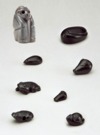
Near East, Babylonian, Eight Zoomorphic Weights, first half
of the 2nd millennium BCE,
haematite, George Ortiz Collection. The largest of these is a
squatting baboon, weight 83.93
grams, height 4.31 cm, width 2.34 cm, depth
2.8 cm. The others: three shells, two frogs, a boar's head, and
a duck, each highly polished.
Also see animalia, anthropomorphic, singerie, and equine art.
zoopraxiscope - A moving picture projector invented by Eadweard Muybridge (English-American, 1830-1904). Muybridge pioneered the taking of series of photographs employing a series of cameras. He printed these as sheets of sequenced exposures. In order to recreate a moving image from his still sequences, Muybridge developed the zoopraxiscope. It was first used at the home of Leland Stanford, former Governor of California, in 1879, and subsequently in Muybridge's lectures. See Eadweard Muybridge photos reproduced at the "Masters of Photography" site.
Also see animation, camera, cinema, magic lantern, movement, optics, and zoetrope.
https://inform.quest/_art
Copyright © 1996-![]()